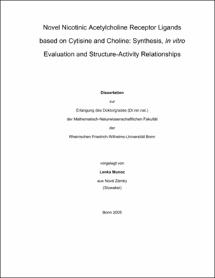Munoz, Lenka: Novel Nicotinic Acetylcholine Receptor Ligands based on Cytisine and Choline : Synthesis, In vitro Evaluation and Structure-Activity Relationships. - Bonn, 2005. - Dissertation, Rheinische Friedrich-Wilhelms-Universität Bonn.
Online-Ausgabe in bonndoc: https://nbn-resolving.org/urn:nbn:de:hbz:5N-06457
Online-Ausgabe in bonndoc: https://nbn-resolving.org/urn:nbn:de:hbz:5N-06457
@phdthesis{handle:20.500.11811/2330,
urn: https://nbn-resolving.org/urn:nbn:de:hbz:5N-06457,
author = {{Lenka Munoz}},
title = {Novel Nicotinic Acetylcholine Receptor Ligands based on Cytisine and Choline : Synthesis, In vitro Evaluation and Structure-Activity Relationships},
school = {Rheinische Friedrich-Wilhelms-Universität Bonn},
year = 2005,
note = {It has been long accepted that targeting nAChRs represent a pathway for the treatment of various CNS-related and non CNS-related disorders (e.g. Alzheimer's and Parkinson's disease, schizophrenia, depression, inflammation, pain). Advances in medicinal chemistry, molecular biology and behavioural pharmacology have resulted in a better understanding of the role of nAChRs in the pathological processes as well as in a development of various structurally different nicotinic ligands, whereas several agents have entered clinical trials.
The presented thesis was focused on development of novel nAChR ligands based on cytisine and choline. The synthesized compounds enrich the nAChR pharmacopoeia and the collective findings of biological evaluation greatly extend the knowledge of structure-activity relationship for the leads cytisine and choline.
It has been shown that bulky aryl substituents attached to the cytisine skeleton decrease the affinity of the lead to the alpha4beta2 nACh receptor, while smaller nitrogen bearing heteroaryls in the position 3 afford ligands with picomolar affinity. Substitution of the position 5 in cytisine leads to an improved selectivity for central nicotinic receptor over nAChRs in the peripheral nervous system and this makes the 5-substituted analogues very interesting. Since the partial agonist behaviour of cytisine provides pharmacological profile required for the treatment of smoking cessation, it is almost essential in the future to test the activities of these ligands. Cytisine has been recently evaluated as an antidepressive drug and several novel derivatives presented herein are currently under investigation in a depression test system at Yale University in New Haven, USA.
Carbamates bearing N-methyl-pyrrolidine or N-methyl-piperidine moiety have been shown to possess lower affinity for alpha7 nAChR than their analogues in the quinuclidine series, although the same structural elements are present (a protonable basic nitrogen, a carbamate moiety and a π-electron system). However, the carbamate bond as a link between a quinuclidine core and the π-electron system provides a template for high affinity ligands with alpha7-subtype selectivity, whereas replacement of the quinuclidine moiety by other azacyclic cores, such as N-methylpyrrolidine or N-methylpiperidine, provides ligands with prevalance for alpha4beta2 nAChRs. Since the carbamate bond is easily hydrolyzed and does not show a predisposition for an alpha7-selective ligand, it might be replaced by e.g. an amide bond. A library of compounds, in which various azacyclic cores are linked to a pielectron system via an amide bond, would offer new and interesting nAChRs ligands.},
url = {https://hdl.handle.net/20.500.11811/2330}
}
urn: https://nbn-resolving.org/urn:nbn:de:hbz:5N-06457,
author = {{Lenka Munoz}},
title = {Novel Nicotinic Acetylcholine Receptor Ligands based on Cytisine and Choline : Synthesis, In vitro Evaluation and Structure-Activity Relationships},
school = {Rheinische Friedrich-Wilhelms-Universität Bonn},
year = 2005,
note = {It has been long accepted that targeting nAChRs represent a pathway for the treatment of various CNS-related and non CNS-related disorders (e.g. Alzheimer's and Parkinson's disease, schizophrenia, depression, inflammation, pain). Advances in medicinal chemistry, molecular biology and behavioural pharmacology have resulted in a better understanding of the role of nAChRs in the pathological processes as well as in a development of various structurally different nicotinic ligands, whereas several agents have entered clinical trials.
The presented thesis was focused on development of novel nAChR ligands based on cytisine and choline. The synthesized compounds enrich the nAChR pharmacopoeia and the collective findings of biological evaluation greatly extend the knowledge of structure-activity relationship for the leads cytisine and choline.
It has been shown that bulky aryl substituents attached to the cytisine skeleton decrease the affinity of the lead to the alpha4beta2 nACh receptor, while smaller nitrogen bearing heteroaryls in the position 3 afford ligands with picomolar affinity. Substitution of the position 5 in cytisine leads to an improved selectivity for central nicotinic receptor over nAChRs in the peripheral nervous system and this makes the 5-substituted analogues very interesting. Since the partial agonist behaviour of cytisine provides pharmacological profile required for the treatment of smoking cessation, it is almost essential in the future to test the activities of these ligands. Cytisine has been recently evaluated as an antidepressive drug and several novel derivatives presented herein are currently under investigation in a depression test system at Yale University in New Haven, USA.
Carbamates bearing N-methyl-pyrrolidine or N-methyl-piperidine moiety have been shown to possess lower affinity for alpha7 nAChR than their analogues in the quinuclidine series, although the same structural elements are present (a protonable basic nitrogen, a carbamate moiety and a π-electron system). However, the carbamate bond as a link between a quinuclidine core and the π-electron system provides a template for high affinity ligands with alpha7-subtype selectivity, whereas replacement of the quinuclidine moiety by other azacyclic cores, such as N-methylpyrrolidine or N-methylpiperidine, provides ligands with prevalance for alpha4beta2 nAChRs. Since the carbamate bond is easily hydrolyzed and does not show a predisposition for an alpha7-selective ligand, it might be replaced by e.g. an amide bond. A library of compounds, in which various azacyclic cores are linked to a pielectron system via an amide bond, would offer new and interesting nAChRs ligands.},
url = {https://hdl.handle.net/20.500.11811/2330}
}






